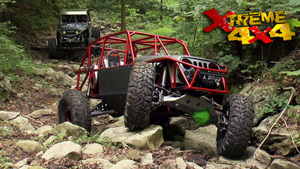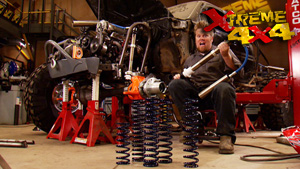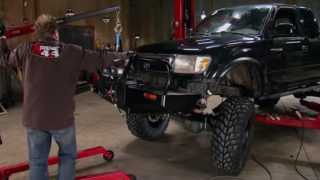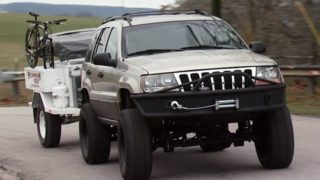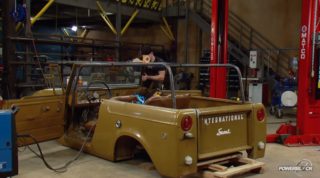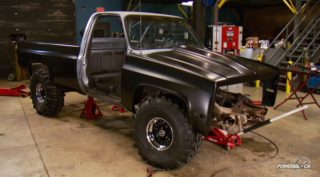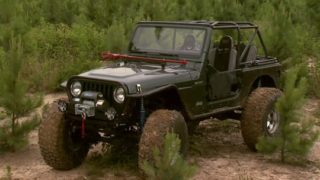More Toyota Mini Episodes
Xtreme 4x4 Builds
Want more content like this?
Join the PowerNation Email NewsletterParts Used In This Episode
Bend Tech
Computer Program that gives you accurate cut lengths, bending locations, bend angles and bend rotations for all tubing sizes.
Blue Ribbon Coalition
A national non-profit organization dedicated to preserving responsible recreational access to public lands.
Hi-Lift Jack Company
High Lift Jack and Off Road Base.
JE Reel
Front and rear drive shafts.
Lokar
10" Universal Floor Mounted Shifter with a Skull Knob.
Northwest Fab
Black Box - 2.72:1 secondary reduction housing unit - and a set of Triple Stick Cable Shifters.
Prothane
Poly Bushings.
Ramsey
9500 UT Winch, Tree Saver and Snatch Block.
Stak 4x4
32 Spline Transfer Case Input Shaft.
Trick Tools
Pipe Master Tubing Contour Guage.
United 4-Wheel Drive Association
An organization that encompasses getting together for 4WD adventures, camping trips and weekend rallies.
Episode Transcript
Is anything off road completely bulletproof. Today on Xtreme 4x4, we attempt to find out when our Toyota mini truck returns for drive line upgrades followed by a really hot payoff
plus some safety tips that'll keep your truck on the straight and narrow.
You know, every off road junkie knows that Murphy's law goes hand in hand
with four wheelers and it doesn't matter how experienced you are, if something can go wrong, it will go wrong or another one of Murphy's laws, every solution breeds new problems.
Well, not in our case because today we pulled our Toyota mini truck back into the shop to take care of a couple of issues that came up and we had this truck
right on the trail.
And as soon as we fix the truck, we're going to take it back out on the trail to make sure that we solved all the problems. But instead of just driving it, we're also going to show you some driving tips as well as some recovery techniques and procedures.
Now, if you remember this Toyota mini truck showed up in the shop, bone stock with a bad engine and before long, it was transformed into a hard core wheeler.
It all started with a popular body mod in the rear of Bob and dovetail, shortening the truck's frame and bed.
Then once all the ifs suspension was cut off, a solid axle swap was performed and a new drive train installed including a Ram jet 3, 5700 R four and a stack three speed transfer case.
Then with 37 inch tires on steel bead locks bolted up to some chrome Molly filled Yoda axles, the truck hit the trails. Unfortunately,
the trails hit back.
Now with everything installed on the truck, we had a pretty serious angle on our front drive shaft. Unfortunately, when we got the front axle in a bind, it broke the yoke right at the transfer case. And luckily, we were able to fix it on the trail and keep wheeling for the day, but we were a little gun shy, not able to really test this truck with just a temporary fix. And today we're going to take care of that.
You guys know exactly what we're talking about. You build what seems to be the perfect drive train and then you get it in your truck and there's problems. But that's one of the greatest things about being a four
wher is finding solutions to the weakest link even if the weakest link was created by yourself. Now, of course, we had a lot of options, but we decided to go ahead and relocate this transfer case far back in the chassis behind a secondary reduction housing
a secondary reduction box does exactly what the name implies. It mounts behind the transmission and offers us another gear level of reduction before the power even gets the transfer case. Now, for our Toyota mini truck, we chose a Northwest fab black box unit. It's 360 degrees of clock ability make mounting the shifter cable, no problem at all. Now, the two
0.72 to one gear reduction is accomplished by a heavy duty planetary gear set mounted on a 4340 heat treated main shaft and it's all housed in a super thick walled housing.
Now, the black box is one of the only aftermarket reduction housings that offered bearing support for that main shaft on both the front and rear output. Therefore, making this thing super strong
the small size and the fact that the black box unit is perfectly round makes it easy to fit into tight places
when installing a reduction box in front of a transfer case. The only real issue is the severe strain on the input here in the transfer case.
Now, the 700 are four has a 27 spline output shaft which is originally what our stack case had when we ordered it.
But to beef it up stack four by four, set us a 32
input.
Now, if the transfer case move further back between the frame rails, there's a lot of leverage on the output housing of the transmission and all that leverage will cause it to break. So to support the weight of the transfer case, we're going to add another cross member right behind it
with some poly bushings from propane inside inch and three quarter tubing tabs are welded to the frame of the truck. A
piece of tubing bent and notch becomes the cross member
and then a large plate is bolted to the case.
Now, we know that the extra weight of this set up will not be a problem.
We had to modify both our front and rear drive shafts. Now that the transfer case is a lot closer to the rear axle and a lot farther away from the front axle, one called the Je reel and they hooked us up with a set of brand new shafts to replace our old ones.
Thank
you.
The rear is a three inch two piece unit with the hangar bearing in the stock location for the Toyota truck.
The front is a long travel two inch shaft and now we have a perfect angle even with our suspension at full droop.
After the break, our Yoda mini is treated to quintuple shifters
then taken out for a leisurely drive.
Stay tuned.
Welcome back to Xtreme 4x4. Now that reduction box mounted between our transmission and transfer case, we start to work on some shifters for all three units. Now, with the transfer case farther back in between the frame rails, we can go ahead and modify the shifters to fit. But as you guys know, getting those shifters placed inside the cab can be kind of difficult, especially when the
location is right underneath the passenger seat.
So to solve that problem, we had Northwest that build us a set of triple stick cable shifters.
They built with a more type cable that allows them to be easily manipulated into small areas. Plus they can be built for any transfer.
First, the brackets need to be bolted onto the case. Then the cable ends can be threaded on to the shift rails.
Now we prefab this center console before the stack case even went in.
And now that we have the shifter plate made, we can go ahead and finish mounting the shifters.
And for the rear, we had to cut out a lot of the floor to clear the transfer case to keep it tucked up on the truck
and to cover it up. We got trick solution bam
money,
dollar dollar bills.
Yeah.
Now the black box also shifts using a cable and with the shifter mounted inside the truck, we can go ahead and hook this up. It first goes through a mounting flange, it's bolted onto the back of the transmission
and then this lever will bolt on to the side of the black box. One item that did not make it into our last show when we put in the drive train was the shifter. We chose this low car 10 inch universal floor mounted shifter with a school knob that has one single button to unlock the shift gates to make it easy to shift from first reverse.
With the amount to our newly fabricated console, we now have five count five shifters in our truck
time. Now for an Xtreme 4x4 tech tip,
one area that can be difficult to deal with when working with tubing is getting nice, tight fitting notches especially in complicated joints like this one where we have three tubes converging on one common point. Now, we have a couple of tools to show you that make that a lot easier. One is a contour gauge from pipe mount,
it simply slides down the tube before you notch it and gives you a road map of what needs to be trimmed off that tube
in order to make it fit. But if you do a lot of fabrication for just under 300 bucks, you can get a computer program that makes dealing with notches like that as easy as making paper dolls.
It's from Ben
Tech. And once you have the joint drawn in the program, the software calculates all the angles and spits out a schematic called a wrapper for each tube,
just cut them out, wrap them around the tube and you have an exact guideline for notching with either a dedicated notch,
a
plasma cutter
or even a simple hand grinder.
In the end, you're gonna have a nice tight fitting notch. It's perfect
every time
back on Xtreme 4x4 with our newly improved Toyota mini truck
and we built plenty of hard core trail.
But this one was a challenge from the start.
A steep dry shaft angle up front created a weakness at the
Y. And after some broken parts, a trail fix and more broken parts, something had to be done.
So we move the transfer case back with the addition of a secondary reduction box.
This lesson the angle of the shaft. While at the same time, turning our three speed stack into a six speed stack, giving us more gearing options,
low ratio for creeping
and a midrange for hill climbs.
But as most of you guys know the weak link on a truck really never goes away,
just gets moved around a bit
so you can bet our Yoda will be back later for more goodies.
Now, even though we absolutely love four wheeling, we didn't come out here today just for the trail ride. We're actually going to talk about hitting the trails and some stuff that we just never talk about things like proper winching techniques as well as other recovery tips, proper driving techniques to get you in and out of the trail easy. Now, some of you hard core guys, the stuff second nature. But for a lot of you guys out there hitting the trail for the first or second time. You probably find this pretty valuable.
The first thing we're going to talk about is wheel placement. When the truck travels up the trail, the goal is to put one tire on top of the obstacle, not straddle the rocks. Yeah. Come on in.
When the tire drives over stuff on the trail, it will raise the height of the under
and keep it from getting hung up and stuck.
All right. Now, right here is a really good example of straddling because if he actually fell off this rock right here,
his
would be hit and you get hung up.
So it's a perfect example of trying to stay on top of your obstacle.
One of the benefits of having an automatic transmission is the ability to 2 ft drive
by holding 1 ft on the brake and loading the engine up to make the torque converter reach its stall speed,
the truck will crawl forward when I release the brakes.
This helps a lot when trail riding because the truck will not roll backwards off the rocks and stumps.
Two strong guys stacking boulders helps too.
What we're gonna do here
is come around, this corner
truck's gonna tip over
probably ride most but outside.
Now with our Yoda, it's just gonna add more character to the truck
with a lot of dual purpose rigs hitting the trail. Nowadays,
you want to keep them kind of shiny.
So we're gonna go ahead and strap the corner of this truck off of that tree. It'll help hold the body up as Chris drives around the corner, it should help keep it on all fours.
Now, of course, this wouldn't be a very good segment without talking about trail manners. Now, for the most part, we
are very respectable of their land because we want to keep wheeling on it.
But you always have to keep in mind that whether you O HP park or a private park, you're going to want to stay on the trails and follow all of the signs and rules and also get involved,
check in with your local clubs and organizations and help out with some trail maintenance. Also join some national organizations like the United Four Wheel Drive Association or the Blue ribbon Coalition. They're out there working hard to keep these trails open so we can enjoy them for years to come and come on guys. If you take it into the trail, remember, take it out, pick up your trash.
Stay tuned. More hardcore wheeling ahead as our Toyota trail test continues.
Welcome back to Xtreme 4x4. We're out of the shop and on the trail earlier, we pulled our Toyota back into extreme to fix a drive line angle issue we had with it last time we hit the trail. Now that it's all fixed, we're out here again to test it. But this time our trail ride has a little bit of a twist
now, just like we said at the beginning of the show, Murphy's Law can rear its ugly head at any time and when something goes wrong, you gotta have a plan.
So instead of just tooling around on the trails today, we're gonna take a little time to show you some recovery techniques.
Now, the first thing we're gonna talk about is proper winching techniques and how to hook up to something. Well, like a tree.
Thanks Jessi.
And the last time we had the Yoda on the trail, we blew the front yoke off the transfer case and we did a lot of winching. Well, we broke the cardinal rule that day and a lot of you guys called us on it. And so today we're eating some crow and saying sorry that we did it and show you how to do it correctly. What we did was we wrapped the winch cable around the tree and just clipped on itself. What happens is while you winch the truck, the cable actually gets tighter, therefore, choking the nutrients off for the tree's leaves and eventually killing the tree. There's a better solution to that. It's called a tree saver.
It's basically long strap that will wrap around the trunk of the tree. Now, what this does find a soft mounting point to winch from as well as it does not get tighter.
I know a lot of you guys are thinking it's one tree. What's the big deal? Hundreds of them out here?
Well, a lot of the people who are trying to keep us off public land,
use things like dead trees, damage to the trails and stuff like that
as ammunition against us. If each one of us does what we can follow the rules, trails will be open for years to come.
Ok. K law
and go
a lot of the times when you're winching, you don't have a direct line from the stranded vehicle to the winch itself. That's where a snatch block comes in handy. Use that with the tree saver and it will redirect the winch cable right to the stranded vehicle.
Ok. Straight ahead. Trust.
And when it comes to recovery gear, there honestly is nothing more versatile than a high left jack. It can be used as a jack, a clamp, a winch and in remote areas, firemen even use it as a makeshift jaws of life, just ramming it into the truck, jacking up and expanding to recover trap victims. Now, it can lift just under 5000 pounds
with only 100 and 73 pounds at the end of the handle. Now, if you're working in soft ground, it's a great idea to get one of these off road bases. That'll keep the jack from sinking into the ground.
The only thing you gotta watch to make sure you're jacking underneath a nice flat surface, not a tube. So the jack doesn't kick out
and then it's just as simple as jacking the jack up,
get the truck off the ground.
Now, wishing
with the high
left jack is pretty simple. It just takes a little more time
with a chain bolted to the top of the high lift jack. A second chain is attached to a clamp that is bolted to the jacking head.
Then the truckers went forward with the jack
when you need to keep going, attach a piece of short chain from the bottom of the jack to the chain,
this will keep the truck from rolling back.
Then all we have to do is slide the jack back and start over
to take all authority.
Yeah.
So there you have it guys. Our Toyota has redeemed itself out on the trail and our new secondary reduction box sure comes in handy. Now, hopefully we redeemed ourselves by showing you guys the proper winching techniques. So get out there and build something and when you get it stuck, just tug your junk right out.
We're going to leave you now with some sights and sounds of a day four wheeling with the extreme crew
peaceful
who turn off, turn off.
We don't have a fire extinguisher either
the power steering,
it'll burn off.
And
now of course, this wouldn't be a very good segment about.
I'm trying to keep the snot in my nose.
Need.
Bye.
You got,
oh
my God.
Don't you have like a couple of plates and stuff in your back?
Yeah, but I'm not twisting at that part that doesn't hurt.
No, this does not hurt right now.
Perfect.
Love the high left Jack
Chris. We
go grab that for me.
Show Full Transcript
plus some safety tips that'll keep your truck on the straight and narrow.
You know, every off road junkie knows that Murphy's law goes hand in hand
with four wheelers and it doesn't matter how experienced you are, if something can go wrong, it will go wrong or another one of Murphy's laws, every solution breeds new problems.
Well, not in our case because today we pulled our Toyota mini truck back into the shop to take care of a couple of issues that came up and we had this truck
right on the trail.
And as soon as we fix the truck, we're going to take it back out on the trail to make sure that we solved all the problems. But instead of just driving it, we're also going to show you some driving tips as well as some recovery techniques and procedures.
Now, if you remember this Toyota mini truck showed up in the shop, bone stock with a bad engine and before long, it was transformed into a hard core wheeler.
It all started with a popular body mod in the rear of Bob and dovetail, shortening the truck's frame and bed.
Then once all the ifs suspension was cut off, a solid axle swap was performed and a new drive train installed including a Ram jet 3, 5700 R four and a stack three speed transfer case.
Then with 37 inch tires on steel bead locks bolted up to some chrome Molly filled Yoda axles, the truck hit the trails. Unfortunately,
the trails hit back.
Now with everything installed on the truck, we had a pretty serious angle on our front drive shaft. Unfortunately, when we got the front axle in a bind, it broke the yoke right at the transfer case. And luckily, we were able to fix it on the trail and keep wheeling for the day, but we were a little gun shy, not able to really test this truck with just a temporary fix. And today we're going to take care of that.
You guys know exactly what we're talking about. You build what seems to be the perfect drive train and then you get it in your truck and there's problems. But that's one of the greatest things about being a four
wher is finding solutions to the weakest link even if the weakest link was created by yourself. Now, of course, we had a lot of options, but we decided to go ahead and relocate this transfer case far back in the chassis behind a secondary reduction housing
a secondary reduction box does exactly what the name implies. It mounts behind the transmission and offers us another gear level of reduction before the power even gets the transfer case. Now, for our Toyota mini truck, we chose a Northwest fab black box unit. It's 360 degrees of clock ability make mounting the shifter cable, no problem at all. Now, the two
0.72 to one gear reduction is accomplished by a heavy duty planetary gear set mounted on a 4340 heat treated main shaft and it's all housed in a super thick walled housing.
Now, the black box is one of the only aftermarket reduction housings that offered bearing support for that main shaft on both the front and rear output. Therefore, making this thing super strong
the small size and the fact that the black box unit is perfectly round makes it easy to fit into tight places
when installing a reduction box in front of a transfer case. The only real issue is the severe strain on the input here in the transfer case.
Now, the 700 are four has a 27 spline output shaft which is originally what our stack case had when we ordered it.
But to beef it up stack four by four, set us a 32
input.
Now, if the transfer case move further back between the frame rails, there's a lot of leverage on the output housing of the transmission and all that leverage will cause it to break. So to support the weight of the transfer case, we're going to add another cross member right behind it
with some poly bushings from propane inside inch and three quarter tubing tabs are welded to the frame of the truck. A
piece of tubing bent and notch becomes the cross member
and then a large plate is bolted to the case.
Now, we know that the extra weight of this set up will not be a problem.
We had to modify both our front and rear drive shafts. Now that the transfer case is a lot closer to the rear axle and a lot farther away from the front axle, one called the Je reel and they hooked us up with a set of brand new shafts to replace our old ones.
Thank
you.
The rear is a three inch two piece unit with the hangar bearing in the stock location for the Toyota truck.
The front is a long travel two inch shaft and now we have a perfect angle even with our suspension at full droop.
After the break, our Yoda mini is treated to quintuple shifters
then taken out for a leisurely drive.
Stay tuned.
Welcome back to Xtreme 4x4. Now that reduction box mounted between our transmission and transfer case, we start to work on some shifters for all three units. Now, with the transfer case farther back in between the frame rails, we can go ahead and modify the shifters to fit. But as you guys know, getting those shifters placed inside the cab can be kind of difficult, especially when the
location is right underneath the passenger seat.
So to solve that problem, we had Northwest that build us a set of triple stick cable shifters.
They built with a more type cable that allows them to be easily manipulated into small areas. Plus they can be built for any transfer.
First, the brackets need to be bolted onto the case. Then the cable ends can be threaded on to the shift rails.
Now we prefab this center console before the stack case even went in.
And now that we have the shifter plate made, we can go ahead and finish mounting the shifters.
And for the rear, we had to cut out a lot of the floor to clear the transfer case to keep it tucked up on the truck
and to cover it up. We got trick solution bam
money,
dollar dollar bills.
Yeah.
Now the black box also shifts using a cable and with the shifter mounted inside the truck, we can go ahead and hook this up. It first goes through a mounting flange, it's bolted onto the back of the transmission
and then this lever will bolt on to the side of the black box. One item that did not make it into our last show when we put in the drive train was the shifter. We chose this low car 10 inch universal floor mounted shifter with a school knob that has one single button to unlock the shift gates to make it easy to shift from first reverse.
With the amount to our newly fabricated console, we now have five count five shifters in our truck
time. Now for an Xtreme 4x4 tech tip,
one area that can be difficult to deal with when working with tubing is getting nice, tight fitting notches especially in complicated joints like this one where we have three tubes converging on one common point. Now, we have a couple of tools to show you that make that a lot easier. One is a contour gauge from pipe mount,
it simply slides down the tube before you notch it and gives you a road map of what needs to be trimmed off that tube
in order to make it fit. But if you do a lot of fabrication for just under 300 bucks, you can get a computer program that makes dealing with notches like that as easy as making paper dolls.
It's from Ben
Tech. And once you have the joint drawn in the program, the software calculates all the angles and spits out a schematic called a wrapper for each tube,
just cut them out, wrap them around the tube and you have an exact guideline for notching with either a dedicated notch,
a
plasma cutter
or even a simple hand grinder.
In the end, you're gonna have a nice tight fitting notch. It's perfect
every time
back on Xtreme 4x4 with our newly improved Toyota mini truck
and we built plenty of hard core trail.
But this one was a challenge from the start.
A steep dry shaft angle up front created a weakness at the
Y. And after some broken parts, a trail fix and more broken parts, something had to be done.
So we move the transfer case back with the addition of a secondary reduction box.
This lesson the angle of the shaft. While at the same time, turning our three speed stack into a six speed stack, giving us more gearing options,
low ratio for creeping
and a midrange for hill climbs.
But as most of you guys know the weak link on a truck really never goes away,
just gets moved around a bit
so you can bet our Yoda will be back later for more goodies.
Now, even though we absolutely love four wheeling, we didn't come out here today just for the trail ride. We're actually going to talk about hitting the trails and some stuff that we just never talk about things like proper winching techniques as well as other recovery tips, proper driving techniques to get you in and out of the trail easy. Now, some of you hard core guys, the stuff second nature. But for a lot of you guys out there hitting the trail for the first or second time. You probably find this pretty valuable.
The first thing we're going to talk about is wheel placement. When the truck travels up the trail, the goal is to put one tire on top of the obstacle, not straddle the rocks. Yeah. Come on in.
When the tire drives over stuff on the trail, it will raise the height of the under
and keep it from getting hung up and stuck.
All right. Now, right here is a really good example of straddling because if he actually fell off this rock right here,
his
would be hit and you get hung up.
So it's a perfect example of trying to stay on top of your obstacle.
One of the benefits of having an automatic transmission is the ability to 2 ft drive
by holding 1 ft on the brake and loading the engine up to make the torque converter reach its stall speed,
the truck will crawl forward when I release the brakes.
This helps a lot when trail riding because the truck will not roll backwards off the rocks and stumps.
Two strong guys stacking boulders helps too.
What we're gonna do here
is come around, this corner
truck's gonna tip over
probably ride most but outside.
Now with our Yoda, it's just gonna add more character to the truck
with a lot of dual purpose rigs hitting the trail. Nowadays,
you want to keep them kind of shiny.
So we're gonna go ahead and strap the corner of this truck off of that tree. It'll help hold the body up as Chris drives around the corner, it should help keep it on all fours.
Now, of course, this wouldn't be a very good segment without talking about trail manners. Now, for the most part, we
are very respectable of their land because we want to keep wheeling on it.
But you always have to keep in mind that whether you O HP park or a private park, you're going to want to stay on the trails and follow all of the signs and rules and also get involved,
check in with your local clubs and organizations and help out with some trail maintenance. Also join some national organizations like the United Four Wheel Drive Association or the Blue ribbon Coalition. They're out there working hard to keep these trails open so we can enjoy them for years to come and come on guys. If you take it into the trail, remember, take it out, pick up your trash.
Stay tuned. More hardcore wheeling ahead as our Toyota trail test continues.
Welcome back to Xtreme 4x4. We're out of the shop and on the trail earlier, we pulled our Toyota back into extreme to fix a drive line angle issue we had with it last time we hit the trail. Now that it's all fixed, we're out here again to test it. But this time our trail ride has a little bit of a twist
now, just like we said at the beginning of the show, Murphy's Law can rear its ugly head at any time and when something goes wrong, you gotta have a plan.
So instead of just tooling around on the trails today, we're gonna take a little time to show you some recovery techniques.
Now, the first thing we're gonna talk about is proper winching techniques and how to hook up to something. Well, like a tree.
Thanks Jessi.
And the last time we had the Yoda on the trail, we blew the front yoke off the transfer case and we did a lot of winching. Well, we broke the cardinal rule that day and a lot of you guys called us on it. And so today we're eating some crow and saying sorry that we did it and show you how to do it correctly. What we did was we wrapped the winch cable around the tree and just clipped on itself. What happens is while you winch the truck, the cable actually gets tighter, therefore, choking the nutrients off for the tree's leaves and eventually killing the tree. There's a better solution to that. It's called a tree saver.
It's basically long strap that will wrap around the trunk of the tree. Now, what this does find a soft mounting point to winch from as well as it does not get tighter.
I know a lot of you guys are thinking it's one tree. What's the big deal? Hundreds of them out here?
Well, a lot of the people who are trying to keep us off public land,
use things like dead trees, damage to the trails and stuff like that
as ammunition against us. If each one of us does what we can follow the rules, trails will be open for years to come.
Ok. K law
and go
a lot of the times when you're winching, you don't have a direct line from the stranded vehicle to the winch itself. That's where a snatch block comes in handy. Use that with the tree saver and it will redirect the winch cable right to the stranded vehicle.
Ok. Straight ahead. Trust.
And when it comes to recovery gear, there honestly is nothing more versatile than a high left jack. It can be used as a jack, a clamp, a winch and in remote areas, firemen even use it as a makeshift jaws of life, just ramming it into the truck, jacking up and expanding to recover trap victims. Now, it can lift just under 5000 pounds
with only 100 and 73 pounds at the end of the handle. Now, if you're working in soft ground, it's a great idea to get one of these off road bases. That'll keep the jack from sinking into the ground.
The only thing you gotta watch to make sure you're jacking underneath a nice flat surface, not a tube. So the jack doesn't kick out
and then it's just as simple as jacking the jack up,
get the truck off the ground.
Now, wishing
with the high
left jack is pretty simple. It just takes a little more time
with a chain bolted to the top of the high lift jack. A second chain is attached to a clamp that is bolted to the jacking head.
Then the truckers went forward with the jack
when you need to keep going, attach a piece of short chain from the bottom of the jack to the chain,
this will keep the truck from rolling back.
Then all we have to do is slide the jack back and start over
to take all authority.
Yeah.
So there you have it guys. Our Toyota has redeemed itself out on the trail and our new secondary reduction box sure comes in handy. Now, hopefully we redeemed ourselves by showing you guys the proper winching techniques. So get out there and build something and when you get it stuck, just tug your junk right out.
We're going to leave you now with some sights and sounds of a day four wheeling with the extreme crew
peaceful
who turn off, turn off.
We don't have a fire extinguisher either
the power steering,
it'll burn off.
And
now of course, this wouldn't be a very good segment about.
I'm trying to keep the snot in my nose.
Need.
Bye.
You got,
oh
my God.
Don't you have like a couple of plates and stuff in your back?
Yeah, but I'm not twisting at that part that doesn't hurt.
No, this does not hurt right now.
Perfect.
Love the high left Jack
Chris. We
go grab that for me.







